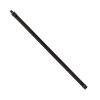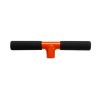AMS 5/8" Threaded Soil Augers
Features
- 5/8" thread for the majority of soil auger diameters
- Economical and secure
- Versatile connection options
- Expedited repair and warranty service
- Lifetime technical support
- More
Threaded Connection ⅝ "
Similar in form to a nuts and bolts system, the AMS threaded connection is reliable and simple to use. Always ensure connection types match when using AMS samplers.
Regular Soil Augers
AMS Regular Augers are designed for use in most soil types. The AMS regular soil auger is commonly used for obtaining disturbed soil samples at or near the surface and for boring to depths where soil samples may be obtained with a separate soil sampler or soil core sampler. The bits of the regular soil auger are open to allow entry of small soil clumps and relatively small rocks and particles.
Mud Augers
AMS Mud Augers utilize a laser-cut, open cylinder design for easy removal of heavy, wet, or clay soils. The AMS mud auger features two openings in the cylinder wall to facilitate emptying as well as wider spaced bits than the AMS regular soil auger to ease entry of sticky soils.
Sand Augers
AMS Sand Augers are designed for use in sands and dry soils. The AMS sand auger uses a closed bit design with a restricted opening to prevent the loss of sampled material during retrieval. The sand auger has a cylinder similar to the regular soil auger, but the inner edges of the sand auger bits touch at their mid point to make the sand auger a much more reliable auger in loose, unconsolidated soil conditions.
Dutch Augers
The AMS Dutch Auger allows you to easily collect disturbed soil samples in heavily rooted areas. Hand forged from high-carbon steel and honed to a fine cutting edge, this auger will cut through highly fibrous and heavily rooted soils. It is excellent for use in, forests, vineyards and orchards. The unique open design of the dutch auger also allows for easier removal of hard or wet soils.
Planer Augers
The AMS Planer Auger removes loose soil and other materials from the bottom of an already augered hole. This auger is fitted with a cutting blade on the underside of the auger cylinder. The flat, slotted design of the planer auger's head allows for the auger to remove loose material from the bottom of a borehole in preparation for collection of a soil core sample. The AMS Planer Auger is made with a carbon steel bail, stainless steel cylinder and tungsten carbide hard surfaced carbon steel cutting blade.
Edelman Augers
Edelman augers are widely used for the study of soil composition, soil profiling, and soil mapping. They feature a screw-like point at the base of the auger that enters into the soil as you push and turn the auger clockwise. The soil sample is guided into the auger by two vaulted vertical cutting blades. The vaulted design promotes soil digging and ensures a firm hold of the sample in the auger.
Flighted Augers
The triple-lead flighted screw augers are able to bore holes in compacted soil lithologies to allow the user to collect a disturbed soil sample. They weigh less than regular flighted screw augers, and they are constructed using carbon steel and a precise heat-treating and hardening process – making them some of the strongest soil augers available.
Flighted auger sampling kits that utilize powered drills are also available for those who need to go deeper, faster. *Not for Use with ANY Hammer Drills!
In The News
Three Decades of Research at Acton Lake
A multi-disciplinary team at Miami University, Ohio, has been studying the environmental change at Acton Lake for over three decades. Using three different NexSens buoys over this time, the team has an incredible archive of data that is helping build a picture of Acton’s past, present, and future. Until recently, a NexSens CB-50 buoy was used alongside other environmental monitoring at Acton Lake. In May 2025, the Miami team deployed a new XB-200 buoy , future-proofing their ongoing monitoring using real-time buoy systems. Acton Lake, a small hypereutrophic reservoir in southwest Ohio, covers 2.4km² and has a maximum depth of about 8m. The dam was built in 1956, and the lake has a large agricultural watershed.
Read MoreSource Water Monitoring in Albany, New York: Tracing Water Quality throughout Tributaries
Thousands of US cities pull their drinking water from natural source waters like reservoirs, rivers, and streams, making overall watershed health a key consideration for water providers. In Albany, New York, the Albany Department of Water and Water Supply delivers drinking water to over 100,000 residents as well as monitors and manages the larger drinking water supply watershed. Hannah Doherty, Environmental Specialist at the Albany Department of Water and Water Supply , spends her days working with a small team to monitor the drinking supply and the connected water bodies. Doherty explains, “We’re the first to encounter the water that ends up being the drinking water.
Read MoreWildfire Prevention in the Sierra Nevada Region with the Yuba Watershed Institute
Though recent wildfires have sparked new conversations about wildfire management and response, groups like the Yuba Watershed Institute have been monitoring the forests and water resources of the Sierra Nevada region for decades, managing approximately 5,000 acres of land with the Bureau of Land Management (BLM) and about 7,000 acres in private land partnerships. The goal of the Institute is to work with local communities and land agencies to improve watershed and forestry management through informed practices and public outreach. The goals of the Yuba Watershed Institute are three-fold: Improve the ability of fire suppression agencies like the California Department of Forestry and Fire Protection ( CAL FIRE ) and the US Forest Service.
Read More



























































